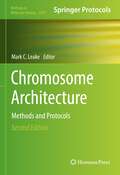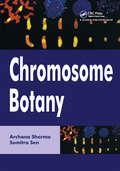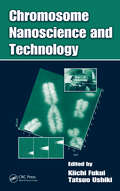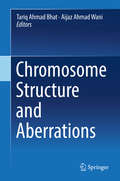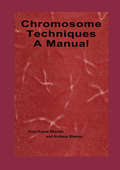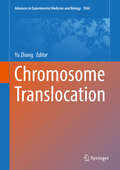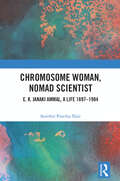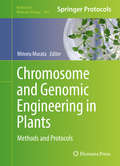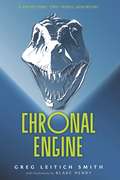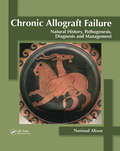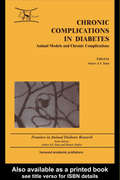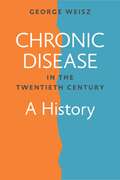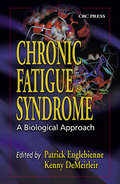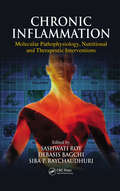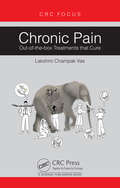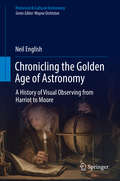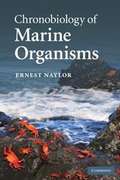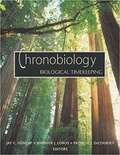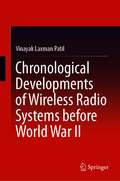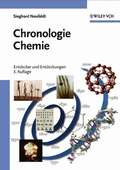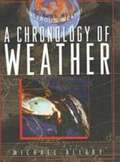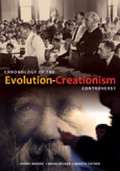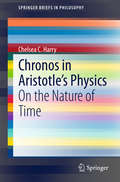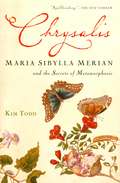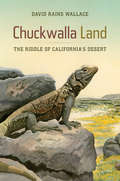- Table View
- List View
Chromosome Architecture: Methods and Protocols (Methods in Molecular Biology #2476)
by Mark C. LeakeThis detailed new edition collects cutting-edge laboratory protocols, techniques, and applications in use by some of the leading international experts in the broad field of chromosome architecture. The book emphasizes the increasing physiological relevance of chromosome architecture investigation, manifest both through application of more complex bottom-up assays in vitro as well as through maintaining the native physiological context through the investigation of living, functional cells. In addition, the chapters reflect the dramatic improvement in the length scale of precision by utilizing single-molecule approaches, both for imaging the DNA content of chromosome and proteins that bind to DNA as well as using methods that can controllably manipulate single DNA molecules, and the use of advanced computational methods and mathematical analysis is also featured. Written for the highly successful Methods in Molecular Biology series, chapters include introductions to their respective topics, lists of the necessary materials and reagents, step-by-step, readily reproducible laboratory protocols, and tips on troubleshooting and avoiding known pitfalls. Authoritative and up-to-date, Chromosome Architecture: Methods and Protocols, Second Edition is an ideal guide for researchers working in this dynamic area of study.
Chromosome Botany
by Archana SharmaThe book covers both the basics of plant chromosomes as well as advances such as molecular characteristics, to give the reader an understanding of the chromosome as vehicle of hereditary transmission. It is meant for all levels of students in genetics, evolution, and biodiversity.
Chromosome Nanoscience and Technology
by Kiichi Fukui Tatsuo UshikiDespite progress in genetic research, knowledge about the exact structure of the chromosome continues to provide a challenge. Much of that challenge lies with the need for improved tools and methods that researchers require to perform novel analyses beyond the DNA level. Fortunately, rapid advances in nanotechnology, are now being employed to exami
Chromosome Structure and Aberrations
by Tariq Ahmad Bhat Aijaz Ahmad WaniThis book is a compilation of various chapters contributed by a group of leading researchers from different countries and covering up to date information based on published reports and personal experience of authors in the field of cytogenetics. Beginning with the introduction of chromosome, the subsequent chapters on organization of genetic material, karyotype evolution, structural and numerical variations in chromosomes, B-chromosomes and chromosomal aberrations provide an in-depth knowledge and easy understanding of the subject matter. A special feature of the book is the inclusion of a series of chapters on various types of chromosomal aberrations and their impact on breeding behaviour and crop improvement. The possible mechanism, their consequences and role in genetic analysis has been emphasized in these chapters. A few chapters have also been dedicated on various techniques routinely used in the laboratory by students and researchers. Each chapter ends with an extensive bibliography so that the students and researchers may find it relevant to consult more literature on the subject than a book of this size can offer. The book is intended to fulfill the needs of undergraduate and post graduate students of botany, zoology and agriculture besides, teachers and researchers engaged in the field of genetics, cytogenetics, and molecular genetics. In general the readers will find each chapter of the book informative and easy to understand.
Chromosome Techniques: Theory And Practice
by Archarna SharmaThis laboratory manual covers the study of chromosomes in plants, animal and human systems, dealing with the protocols and principles involved. It caters to the requirements of scientists working laboratories, presenting details of the operational mechanism for use at the chromosome level.
Chromosome Translocation (Advances in Experimental Medicine and Biology #1044)
by Yu ZhangThis volume discusses various aspects of mechanisms and methodologies of chromosome translocations, ranging from a historical and clinical overview of chromosome translocations to the rapid development of the next-generation sequencing technologies, which has dramatically increased our understanding of the spectrum of chromosome translocations in human diseases.The book also introduces the mechanistic studies on chromosome deletions and their implications in cancer, and discusses the mechanisms of regulating chromothripsis, a unique complex type of chromosome translocation.It is a valuable resource for students and researchers alike, providing insights into chromosome translocations and, potentially, other genomic aberrations involved in understanding and curing human diseases.
Chromosome Woman, Nomad Scientist: E. K. Janaki Ammal, A Life 1897–1984
by Savithri Preetha NairThis is the first in-depth and analytical biography of an Asian woman scientist—Edavaleth Kakkat Janaki Ammal (1897–1984). Using a wide range of archival sources, it presents a dazzling portrait of the twentieth century through the eyes of a pioneering Indian woman scientist, who was highly mobile, and a life that intersected with several significant historical events—the rise of Nazi Germany and World War II, the struggle for Indian Independence, the social relations of science movement, the Lysenko affair, the green revolution, the dawn of environmentalism and the protest movement against a proposed hydro-electric project in the Silent Valley in the 1970s and 1980s. The volume brings into focus her work on mapping the origin and evolution of cultivated plants across space and time, to contribute to a grand history of human evolution, her works published in peer-reviewed Indian and international journals of science, as well as her co-authored work, Chromosome Atlas of Cultivated Plants (1945), considered a bible by practitioners of the discipline. It also looks at her correspondence with major personalities of the time, including political leaders like Jawaharlal Nehru, biologists like Cyril D. Darlington, J. B. S. Haldane and H. H. Bartlett, geographers like Carl Sauer and social activists like Hilda Seligman, who all played significant roles in shaping her world view and her science. A story spanning over North America, Europe and Asia, this biography is a must-have for scholars and researchers of science and technology studies, gender studies, especially those studying women in the sciences, history and South Asian studies. It will also be a delight for the general reader.
Chromosome and Genomic Engineering in Plants: Methods and Protocols (Methods in Molecular Biology #1469)
by Minoru MurataThis volume assembles protocols for chromosome engineering and genome editing in two recently developed approaches for manipulating chromosomal and genomic DNA in plants. The first approach is a plant chromosome vector system, which allows the introduction of desired genes or DNA into target sites on the chromosome vector, particularly by sequence-specific recombination. The second approach is genome-editing, which makes it possible to introduce mutations into any of the genes of DNA that we wish to change. In addition, this book also covers other related techniques used to accelerate progress in plant chromosome and genome engineering. Written in the highly successful Methods in Molecular Biology series format, chapters include introductions to their respective topics, lists of the necessary materials and reagents, step-by-step, readily reproducible laboratory protocols, and tips on troubleshooting and avoiding known pitfalls. Cutting-edge and thorough, Chromosome and Genomic Engineering in Plants: Methods and Protocols provides a comprehensive source of protocols and other necessary information to anyone interested in this field of study. "
Chronal Engine
by Blake Henry Greg Leitich SmithWhen Max, Kyle, and Emma are sent to live with their reclusive grandfather, they think he's crazy, especially when he tells them about his time machine. But after Emma is kidnapped at the exact time that her grandfather predicted, Max and Kyle are forced to believe his eccentric stories--even the one about the Chronal Engine in the basement. Now, to save Emma, Max, Kyle, and their new friend Petra must pile into a VW Bug, and use the Chronal Engine to take the road trip of a lifetime--right back to the Cretaceous period. With dangers all around, the teens find themselves dodging car-crushing herbivores in addition to the terrifying T. rex. In this ancient environment, can three contemporary teens hunt down a kidnapper, forage for food, and survive long enough to return home?
Chronic Allograft Failure: Natural History, Pathogenesis, Diagnosis and Management
by Nasimul AhsanThis book addresses one of the largest unmet needs in transplantation, the need to reduce late allograft loss. In the current era, it is reasonable to expect that most allografts will serve their recipients through their life span and death with preserved graft function the ultimate goal for all transplant recipients. However, long term allograft s
Chronic Complications in Diabetes: Animal Models and Chronic Complications (Frontiers in Animal Diabetes Research)
by Anders A SimaIndividual volumes in the series Frontiers in Animal Diabetes Research provide basic researchers as well as clinical investigators with in-depth coverage of basic experimental diabetes research. Each volume will be topic oriented with timely and liberally referenced reviews. The book provides a valuable reference source for basic researchers as well as clinical investigators, graduate students and research fellows in the areas of diabetology, endocrinology, physiology, and pharmacology.
Chronic Disease in the Twentieth Century: A History
by George WeiszHow the evolving concept of chronic disease has affected patients and politics in the United States and Europe.Long and recurring illnesses have burdened sick people and their doctors since ancient times, but until recently the concept of "chronic disease" had limited significance. Even lingering diseases like tuberculosis, a leading cause of mortality, did not inspire dedicated public health activities until the later decades of the nineteenth century, when it became understood as a treatable infectious disease. Historian of medicine George Weisz analyzes why the idea of chronic disease assumed critical importance in the twentieth century and how it acquired new meaning as one of the most serious problems facing national healthcare systems. Chronic Disease in the Twentieth Century challenges the conventional wisdom that the concept of chronic disease emerged because medicine's ability to cure infectious disease led to changing patterns of disease. Instead, it suggests, the concept was constructed and has evolved to serve a variety of political and social purposes. How and why the concept developed differently in the United States, the United Kingdom, and France are central concerns of this work. In the United States, anxiety about chronic disease spread early in the twentieth century and was transformed in the 1950s and 1960s into a national crisis that helped shape healthcare reform. In the United Kingdom, the concept emerged only after World War II, was associated almost exclusively with proper medical care for the elderly population, and became closely linked to the development of geriatrics as a specialty. In France, the problems of elderly and infirm people were handled as technical and administrative matters until the 1950s and 1960s, when medical treatment of elderly people emerged as a subset of their wider social marginality. While an international consensus now exists regarding a chronic disease crisis that demands better forms of disease management, the different paths taken by these countries during the twentieth century continue to exert profound influence. This book seeks to explain why, among the innumerable problems faced by societies, some problems in some places become viewed as critical public issues that shape health policy.
Chronic Fatigue Syndrome: A Biological Approach
by Patrick Englebienne Kenny DeMeirleirChronic Fatigue Syndrome (CFS) is a complex, debilitating disorder, yet few current scientific biomedical books are available on the subject. The nonspecific symptoms, lack of diagnostic tests, and uncertainty as to the cause or causes of CFS make the disease that much more baffling. Chronic Fatigue Syndrome: A Biological Approach represents a monu
Chronic Inflammation: Molecular Pathophysiology, Nutritional and Therapeutic Interventions
by Debasis Bagchi Siba P. Raychaudhuri Sashwati RoyAlthough acute inflammation is a healthy physiological response indicative of wound healing, chronic inflammation has been directly implicated in a wide range of degenerative human health disorders encompassing almost all present day non-communicable diseases including autoimmune diseases, obesity, diabetes and atherosclerosis. Chronic Inflammation
Chronic Pain: Out-of-the-box Treatments that Cure
by Lakshmi Champak VasThe book will reassure those suffering from chronic pain and readers that pains can be treated, and not just be ‘managed’. Contemporary pain management comprises some very sophisticated treatments, which address various parts of the nervous system that have been historically assumed to be responsible for pain. The author's approach is that all neuropathic pains are neuromyopathic with a major muscle pain component where the muscles are the final common factor in all chronic pains. This premise led to the innovation of a new system of pain management, which has been gratifyingly effective, providing cures for many complicated conditions. The book is about the discovery that many types of chronic pain are curable and others easily manageable. The novel concepts developed by the author and her research on pain management are described in this book. These are unique, and will be of interest to doctors, researchers, students, and patients.
Chronicling the Golden Age of Astronomy: A History of Visual Observing from Harriot to Moore (Historical & Cultural Astronomy)
by Neil EnglishThe invention of the telescope at the dawning of the 17th century has revolutionized humanity's understanding of the Universe and our place within it. This book traces the development of the telescope over four centuries, as well as the many personalities who used it to uncover brand-new revelations about the Sun, Moon, planets, stars and distant galaxies.Starting with early observers such as Thomas Harriot, Galileo, Johannes Hevelius, Giovanni Domenico Cassini, Robert Hooke and Christian Huygens, the book explores how these early observers arrived at essentially correct ideas concerning the objects they studied. Moving into the 18th and 19th centuries, the author describes the increasing sophistication of telescopes both large and small, and the celebrated figures who used them so productively, including the Herschels, Charles Messier, William Lassell and the Earls of Rosse.Many great discoveries were also made with smaller instruments when placed in the capable hands of the Struve dynasty, F.W. Bessel, Angelo Secchi and S.W Burnham, to name but a few. Nor were all great observers of professional ilk. The book explores the contributions made by the 'clerical astronomers,' William Rutter Dawes, Thomas William Webb, T.E.R Philips and T.H.E.C Espin, as well as the lonely vigils of E.E. Barnard, William F. Denning and Charles Grover. And in the 20th century, the work of Percival Lowell, Leslie Peltier, Eugene M. Antoniadi, Clyde Tombaugh, Walter Scott Houston, David H. Levy and Sir Patrick Moore is fully explored.Generously illustrated throughout, this treasure trove of astronomical history shows how each observer's work led to seminal developments in science, and providing key insights into how we go about exploring the heavens today.
Chronobiology of Marine Organisms
by Ernest NaylorDo intertidal organisms simply respond to the rise and fall of tides, or do they possess biological timing and navigation mechanisms that allow them to anticipate when conditions are most favourable? How are the patterns of growth, development and reproduction of some marine plants and animals related to changes in day-length or to phases of the moon? The author describes how marine organisms, from single cells to vertebrates, on sea shores, in estuaries and in the open ocean, have evolved inbuilt biological clockwork and synchronisation mechanisms which control rhythmic processes and navigational behaviour, permitting successful exploitation of highly variable and often hostile environments. Adopting a hypothesis-testing and experimental approach, the book is intended for undergraduate and postgraduate students of marine biology, marine ecology, animal behaviour, oceanography and other biological sciences and also as an introduction for researchers, including physiologists, biochemists and molecular biologists entering the field of chronobiology.
Chronobiology: Biological Timekeeping
by Jay C. Dunlap Jennifer J. Loros Patricia J. DeCourseyThe study of how solar- and lunar-related rhythms are governed by living pacemakers within organisms constitutes the scientific discipline of chronobiology. Parallel to the familiar spatial cellular structure of living cells, temporal, or time, organization is a vital part of the survival and normal functioning of every species. Adaptations evolved by organisms to cope with regular geophysical cycles in their environment are evident in nearly every aspect of their lives. In fact, biological timekeeping is a core property of life on a revolving planet. Few fields encompass the breadth of science that is associated with chronobiology. Chronobiologists are at the cutting edge of fields ranging from microbial genetics to ethology to treatment of human psychiatric illnesses. Recognizing that no individual could do justice to the field in writing a comprehensive text, a group of editors with a wide range of experience has collaborated to produce Chronobiology. Chapters have been planned and written by the editors and by teams of specialists. <p><p> The text begins with a general introduction to the formalisms and vocabulary that describe circadian rhythmicity. The behavioral and ecological importance of rhythms is introduced, followed by discussion of the theoretical bases of the fundamental properties that define a circadian rhythm. Circannual rhythms and photoperiodic responses in plants and animals are examined next. A central block of four chapters develops the comparative anatomy, physiology, genetics, and molecular biology of organisms with circadian clocks. Examples at all levels of organization are drawn from the real world and from current and classic research. A pair of chapters then develops the basic circadian organization of human beings and the relevance of circadian biology to human welfare. A final chapter looks to the future by exploring six cutting-edge areas of research. <p><p> The book's highly readable style reduces technical terminology to a minimum and does not require background in neuroscience or mathematics. Illustrations and photographs are used liberally to elucidate conceptually difficult points, and the text makes use of actual data sets to explain basic principles. A collection of color plates condenses the overarching themes of the book into four colorful collages.
Chronological Developments of Wireless Radio Systems before World War II
by Vinayak Laxman PatilThis comprehensive and authoritative volume traces the history of research leading to the development of the wireless radio systems. It discusses the methods adopted by a large number of inventors and the results they obtained to provide perspective on how historical methods and events can be a source of inspiration for future research. This book will be of interest to researchers and students in telecommunications engineering as well as to teachers of history of science and technology.
Chronologie Chemie: Entdecker und Entdeckungen
by Sieghard NeufeldtZwei ereignisreiche Jahrhunderte liegen zwischen der Geburt der modernen Chemie um das Jahr 1800 und der Chemie des dritten Jahrtausends. Während dieser Zeitspanne ist die Chemie von einem Kuriosum für wenige Eingeweihte zu einem unverzichtbaren Motor der wissenschaftlichen und technischen Entwicklung geworden. Die Chemie hat Hungernöte abgewendet (so in Japan in den 1950er Jahren) und Umweltkatastrophen ausgelöst (wie nach der Freisetzung von Dioxin im italienischen Seveso 1976). Der Autor des vorliegenden Buches, selbst ein promovierter Chemiker, hat unvoreingenommen und mit einem Blick für die historische Dimension die Entwicklung dieser faszinierenden Wissenschaft protokolliert. Ob es um die erste wissenschaftlich exakte Darstellung der alkoholischen Gärung, die Entdeckung des Aspirins, der Azofarbstoffe oder der Hochtemperatur-Supraleitung geht - die epochemachenden Entdeckungen und Entwicklungen aus der gesamten Chemie sind hier in 1000 kurzen Artikeln zusammengefasst, chronologisch geordnet und mit den Namen der jeweils beteiligten Männer und Frauen verknüpft. Zu jeden Eintrag sind zusätzlich die wichtigsten Zitate aus der chemischen Originalliteratur angegeben, als Ausgangspunkt für eigene Recherchen. Wer nach verlässlichen und gut aufbereiteten Informationen über die Geschichte der Chemie sucht, kommt an diesem Werk nicht vorbei. "nicht nur eine Zusammenfassung wichtiger chemischer Fakten, sondern auch ein Stück Kulturgeschichte." (Frankfurter Allgemeine Zeitung)
Chronology of Weather (Dangerous Weather)
by Michael AllabyFrom the Book Jacket: A Chronology of Weather presents an overview of the dangerous weather described in preceding volumes in the series. It includes a time line of catastrophic weather events from c. 3,200 B.C. to 1997, as well as a chronology of meteorological discovery-comprising the lives and inventions of great weather scientists-from c. 340 B.c. to 1995. A Chronology of Weather also contains weather experiments that students can perform at home using ordinary household supplies, a glossary of meteorological terms, charts for wind measurement and cloud classification, and further readings suggested by the author. The Dangerous Weather series imparts fundamental weather science to readers through author Michael Allaby's vivid descriptions of extreme weather systems. The series focuses on the five most dangerous kinds of weather activity; diagrams related meteorological, climatological, and environmental basics in clear, compelling language; chronicles the history of each form of dangerous weather; and offers safety precautions for extreme weather conditions. Fully illustrated and indexed, the Dangerous Weather series is an invaluable tool for student research. Other volumes include: hurricanes tornadoes droughts blizzards floods Other books in this series are also available from Bookshare.
Chronology of the Evolution-Creationism Controversy
by Randy Moore Mark Decker Sehoya CotnerChronology of the Evolution-Creationism Controversy describes specific cultural, religious, and scientific events relevant to the evolution-creationism controversy from the first notions of creationism in ancient Egypt to the present.
Chronos in Aristotle's Physics: On the Nature of Time (SpringerBriefs in Philosophy #0)
by Chelsea C. HarryThis book is a contribution both to Aristotle studies and to the philosophy of nature, and not only offers a thorough text based account of time as modally potentiality in Aristotle's account, but also clarifies the process of "actualizing time" as taking time and looks at the implications of conceiving a world without actual time. It speaks to the resurgence of interest in Aristotle's natural philosophy and will become an important resource for anyone interested in Aristotle's theory of time, of its relationship to Aristotle's larger project in the Physics, and to time's place in the broader scope of Aristotelian natural science. Graduate students and scholars researching in this area especially will find the authors arguments provocative, a welcome addition to other recent publications on Aristotle's Treatise on Time.
Chrysalis: Maria Sibylla Merian and the Secrets of Metamorphosis
by Kim ToddThe award-winning science and history writer “gives wings to the life of the artist/naturalist Maria Merian. A lovely and exhilarating book” (Deidre McNamer, author of Aviary).Before Darwin, before Audubon, there was Maria Sibylla Merian.An artist turned naturalist known for her botanical illustrations, Merian was born just sixteen years after Galileo proclaimed that the earth orbited the sun. But at the age of fifty, she sailed from Europe to the New World on a solo scientific expedition to study insect metamorphosis—an unheard-of journey for any naturalist at that time, much less a woman.When she returned, she produced a book that secured her reputation, only to have it savaged in the nineteenth century by scientists who disdained the work of “amateurs.”Exquisitely written and illustrated, Chrysalis takes us from golden-age Amsterdam to the Surinam tropics to modern laboratories where Merian’s insights fuel a new branch of biology. Kim Todd brings to life a seventeenth-century woman whose boldness and vision would still be exceptional today.“In this spellbinding biography, Todd interweaves the life of Maria Sibylla Merian, a German artist and naturalist who became famous in the seventeenth century for her engravings of caterpillars, with the intellectual and scientific history of metamorphosis.” —The New Yorker“Fascinating reading about a little-known, independent woman.” —Science“What makes Chrysalis such a pleasure is that our awe is guided by Merian’s discoveries. Her life was dedicated to understanding and depicting the science of transformation, yet she never lost her enchantment with what few of us could deny is also miraculous.” —Orion
Chuckwalla Land
by David Rains WallaceDescribed as "a writer in the tradition of Henry David Thoreau, John Muir, and other self-educated seers" by the San Francisco Chronicle, David Rains Wallace turns his attention in this new book to another distinctive corner of California--its desert, the driest and hottest environment in North America. Drawing from his frequent forays to Death Valley, Red Rock Canyon, Kelso Dunes, and other locales, Wallace illuminates the desert's intriguing flora and fauna as he explores a controversial, unresolved scientific debate about the origin and evolution of its unusual ecosystems. Eminent scientists and scholars appear throughout these pages, including maverick paleobiologist Daniel Axelrod, botanist Ledyard Stebbins, and naturalists Edmund Jaeger and Joseph Wood Krutch. Weaving together ecology, geology, natural history, and mythology in his characteristically eloquent voice, Wallace reveals that there is more to this starkly beautiful landscape than meets the eye.
